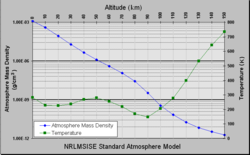Air

Air is the Earth's atmosphere. Air is a mixture of many gases and tiny dust particles. It is the clear gas in which living things live and breathe. It has an indefinite shape and volume. It has mass and weight, because it is matter. The weight of air creates atmospheric pressure. There is no air in outer space.
Earth's atmosphere is composed of about 78 percent nitrogen, 21 percent oxygen, 0.9 percent argon, and 0.1 percent other gases.
Animals live and need to breathe the oxygen in the atmosphere. In breathing, the lungs put oxygen into the blood, and send back carbon dioxide to the air. Plants need the carbon dioxide in the air to live. They give off the oxygen that we breathe. Without it animals die of asphyxia.
Air can be polluted by some gases (such as carbon monoxide, hydrocarbons, and nitrogen oxides), smoke, and ash. This air pollution causes various problems including smog, acid rain and global warming. It can damage people's health and the environment. There are debates about whether or not to act upon climate change, but soon enough the Earth will heat up too much, causing it to become too hot and not support life. Some say fewer people would die of cold weather, and that is true but there is already a huge amount of people dying from heat and that number is and will keep increasing more and more.
Since early times, air has been used to create technology. Ships moved with sails and windmills used the mechanical motion of air. Aircraft use propellers to move air over a wing, which allows them to fly. Pneumatics use air pressure to move things. Since the late 1900s, air power is also used to generate electricity.
Air is invisible: it cannot be seen by the eye, though a shimmering in hot air can be seen.[1]
Air is one of the 4 classical elements (water, air, earth and fire).
Main history
Original atmosphere
At first it was mainly a hydrogen atmosphere. It has changed dramatically on several occasions—for example, the Great Oxygenation Event 2.4 billion years ago, greatly increased oxygen in the atmosphere from practically no oxygen to levels closer to present day. Humans have also contributed to significant changes in atmospheric composition through air pollution, especially since industrialisation, leading to rapid environmental change such as ozone depletion and global warming.
Second atmosphere
Out gassing from volcanism, supplemented by gases produced during the late heavy bombardment of Earth by huge asteroids, produced the next atmosphere, consisting largely of nitrogen plus carbon dioxide and inert gases.[2]
Third atmosphere
The constant re-arrangement of continents by plate tectonics influences the long-term evolution of the atmosphere. Carbon dioxide was transferred to and from large continental carbonate stores. Free oxygen did not exist in the atmosphere until about 2.4 billion years ago. The Great Oxygenation Event is shown by the end of the banded iron formations.
Air Media
Earth's atmosphere from space, showing a blue layer at the stratosphere, above the clouds of the troposphere. The Moon is visible as a crescent in the background.
Afterglow of the troposphere (orange), the stratosphere (blue) and the mesosphere (dark) at which atmospheric entry begins, leaving smoke trails, such as in this case of a spacecraft reentry
In 1960, Joseph Kittinger set a record by parachuting from a gondola at 31.3 km (19.4 mi)
Earth from orbit, showing sunlight filtered into a reddish hue by the troposphere, while casting shadows from different cloud types. The stratosphere forms a thin band of blue scattered sunlight along the horizon.
Temperature and mass density against altitude from the NRLMSISE-00 standard atmosphere model (the eight dotted lines in each "decade" are at the eight cubes 8, 27, 64, ..., 729)
Animation shows the buildup of tropospheric CO2 in the Northern Hemisphere with a maximum around May. The maximum in the vegetation cycle follows in the late summer. Following the peak in vegetation, the drawdown of atmospheric CO2 due to photosynthesis is apparent, particularly over the boreal forests.
Related pages
References
- ↑ "Why is air invisible?".
- ↑ Zahnle K; Schaefer L; & Fegley B. 2010. Earth's earliest atmospheres. Cold Spring Harbor Perspectives in Biology. 2 (10). PMID 20573713
- ↑ Martin, Daniel; McKenna, Helen; Livina, Valerie (2016). "The human physiological impact of global deoxygenation". The Journal of Physiologica. 67 (1): 97–106. doi:10.1007/s12576-016-0501-0. ISSN 1880-6546. PMC 5138252. PMID 27848144.
- ↑ http://www.nap.edu/openbook/0309100615/gifmid/30.gif









